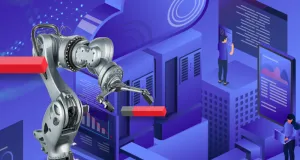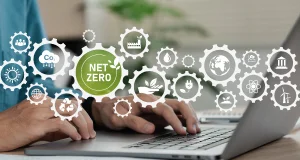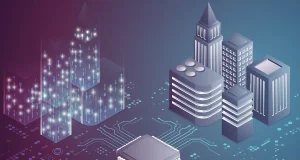This is Tech lyceum. I'm Neerja and we are in for a very insightful few minutes. So buckle up, folks. Today we are diving into the topic of building edge to cloud architecture powered by data platform modernization, and how it ultimately fuels innovation across the manufacturing value chain. To help us understand this better we have two wonderful speakers joining us Jibat Sarkar is here. Jibat is currently the senior client partner leading business relations for key strategic accounts in manufacturing at Birlasoft. He comes with nearly 20 years of global experience anchoring diverse roles across consulting ERP transformation, program management, account management and client partner engagement across various IT enterprises. We also have Ravi Gunturu who is Chief Architect data and analytics HBU at Birlasoft. With more than 30 years of experience in analytics, digital strategy, Big Data Management, cloud transformation programs and systems thinking approach. Ravi has successfully led global teams in numerous analytics projects, driving accelerated business outcomes for organizations Jibat, Ravi, we know we are in for a treat and sharing data is just as important as modernizing it. So thank you so much for doing this.

Thank you for having us.
Yeah. Thank you. Thanks for having us today.
Absolutely. So first question, let me ask you this Jibat if you don't mind starting us off as a manufacturing industry expert.
Q: Can you please tell everybody listening in the key business drivers steering the need for data platform modernization.
The discussion around data platform modernization in the context of the manufacturing clients, it has undergone a shift in the post pandemic world. In the pre pandemic era, this industry was dealing with the advent and relevance of newer technologies in cloud and big data blockchain, AR VR, machine learning AI and IoT, and there was an increased pressure on manufacturers to adopt digital transformation, they wanted to drive value for the shareholders and end customers. Now with the pandemic. This moved the needle from that exploration of the art of the possible to implementation. Traditionally, manufacturing industry has always been about pursuing incremental improvements. Now exponential change was going to be disruptive for them. However, this requires a level of investment leadership buying change management, newer kinds of skills and talent and the appetite to handle risk to business. And this led to implementation of all of these new technologies in many piecemeal projects and pilots. And many of our clients have implemented such capabilities in dealing with the supply shortages during COVID. Their fulfillment planning the supply chain disruptions, supply risks, monitoring, remote work enablement, health and safety, sustainability initiatives, simulation of production scenarios and so on. Those were specific needs of the are, they were addressed with speed, provided the business with the necessary decision support capability that was required at that point in time. Now, when we were discussing how to leverage those investments, there is realization that those lead only to limited benefits. And now we need to look at Broad and strategic applications to drive real change. And the question invariably is, how to sustain these forays that were made to this technology areas. What next, the discussion is proceeding with the customer today is data platform modernization is a journey it covers people both IT and business capability and technology. One of our discrete manufacturing clients who is at a higher level of maturity in data platforms and agile adoption is discussing transcending the traditional boundary of IT related to the value delivery which is ascertain with production of insights they want. And what we are trying to enable is instead of reacting to demand for siloed dashboards, why not manage this business specific analytical capability as a product with incremental additional features and adoption of new technology, this will become a continuous process, providing business with incremental capabilities and influence on the product development process. And this, in turn will drive easier adoption of such capabilities. Another step towards becoming a data driven organization. Another client who has a Data Platform running on disparate multiple technology solutions because they were catering to different units as the demands came in at different points in time. The discussion is hovering around potentially building an ecosystem architecture. So instead of a data analytics platform per se, integrated platform and integrated ecosystem, this would apply Enterprise Architecture principles while adopting AI ml solutions, IoT and other cloud solutions. Because the understanding is that the value lies in convergence and data is the important connective tissue and a comprehensive data ecosystem. will drive the convergence right now with the advent of Gen AI large language models based applications, which are invariably going to drive business growth going forward. Ai risks are also emerging. And these are newer discussions expanding into adoption of guidelines, processes and policies related to managing AI based use cases on the data platform, whether they are custom made, or they are integrated off the shelf solutions. This is another case outlining the need of continuous modernization of the data platform ninja.
Alright, this sounds like a very promising proposition Jibat and Ravi, maybe we can bring it back to
Q: What of things what exactly is data platform modernization? And how does it act as the core foundation for, let's say, an insights driven next manufacturing digital enterprise?
Sure, yeah. Thanks, Neerja. So we have been capturing data and analyzing data for many, many years, if not decades, or centuries, right in terms of using the manufacturing data and processing them. However, in the last 30 40 years, there is a significant movement towards improving productivity through automation, whether it is related to the industrial products, factories, or even the entire manufacturing chain from all the way from planning to service. It's evolving, fast evolving from an analog set to the digital set. This results in generating vast sources of structured and unstructured data. And it's growing exponentially. With every touchpoint, there is multiple volumes of data that is getting generated. So to collect, store and process the data, you need a platform to make sure that it works well. Not just only at that point of time, but also to provide consistency and stability in terms of its usage. So from the data platform, this requires more with a new set of tools available at our disposal, which were not there in the past, whether they are in terms of the cloud, or the new AI driven technologies, it's all about breaking the data from the data silos and bringing them all together and ensuring that we take the maximum advantage that will provide them the thrust for that digital transformation. And it also means that the organization is the enterprises are moving away from a infrastructure world or infrastructure centric world, to a data centric world. Right. Now, in order to, in order for the next gen manufacturing enterprises to excel, there is a continuous need to develop new analytic capabilities that compute, communicate, and collaborate with the data in the most innovative ways. And that's where the modern data platforms are coming into picture. And many organizations are not evolved into taking the latest of the technologies, right. And that's a journey and we from Birlasoft help our clients to seamlessly channelize through the various levels of maturity. And that's where the data platform modernization initiatives come into picture. And we work with our clients and our partners as a larger ecosystem and help drive those changes.
Right. Well, that's interesting. Thank you for taking us through that Ravi. Jibat coming to you
Q: Can you share some manufacturing use cases across the value chain perhaps also touching upon how the organization's benefit from the data modernization approach?
Thanks, Neerja. And I would like to extrapolate the same thing that Ravi talked about the possibilities, as always are endless here, given where we are today in this industry and the technology interventions that are appearing now the versatility of the architecture will be conditioners of the technology and the agility of the methodology have come together to create that critical mass. And the data creation, as Ravi mentioned, is taking place at all layers of the typical ISO 95 architecture in a manufacturing organization. The importance lies in the fact that the speed at which the insights or interventions can be delivered based on the analysis of that huge volume of data that's getting created, whether it's in process at the edge or through the cloud. We unveiled a software advocating that the traditional data and analytics use cases need to continuously undergo modernization taking advantage of these newer capabilities driving reuse, they need to move to decision automation at the right level of customer or consumer in the customers organization and decision support at a different level. For example, if we take a traditional use case at the shopfloor, which is about enhancing equipment efficiency and predictive maintenance, then we need to have the ability to predict, detect and analyze equipment failures thus eliminating production bottlenecks if any, the analytical product in this case should move to intervene and create a maintenance order for the vendor to service equipment, which is an example of decision automation, a superuser. reviewing and approving the order for dispatch looking at dashboards is the capability for decision support similar possibilities of modernization of use cases by virtue of continuous modernization of the data platform is possible. In a Data Platform Modernization Initiative for one of our global manufacturing majors, we are focusing on control in the area of indirect procurement costs is in the same framework, we're looking at spanned we are looking at buyer behavior, and then their systemic interventions that are being planned which is way beyond your traditional data analytics platform. similar cases could be pursued in the area of supply chain deficiencies, with deeper visibility into offers operational efficiency and production quality, given the access to real time production data available now faster time to insight about waste production, carbon emissions, enabling sustainable manufacturing, analyze and supply data to identify best suppliers based on their quality price and delivery performance, then the intervention of AI ml based intelligent demand planning. So there are many such areas which will continuously undergo changes in the way the behavior of those products, those analytical capabilities that are being delivered to the business because the technology is changing. And it has to be a continuous journey, where we continuously ratchet up the performance of each of these capabilities. So then the business always stands to gain and never lagging in terms of consuming these capabilities. Over to you Neerja.
Right, Jibat thank you for sharing those examples. Ravi, one final question for you,
Q: What should be the best data platform modernization strategy that manufacturers must develop so that they can transform themselves into a cloud first AI driven enterprise?
Sure. So when it comes to the data, right data is a is a process. And as we discussed earlier, it includes collecting the data computing on the top of eight communicating with various devices or various ecosystems, and also collaborating with its new forms of Gen AI coming in collaboration also has become much much more important, right. So to put all of them together in the past of a process, we recommend a more thoughtful strategy for the modernization, there is plethora of tools techniques, which are available, but there is no one solution that fits all right. And it includes not just only in terms of the collection, the quality of the data needs to be looked into proper governance needs to be established. Do we have the right data storage mechanisms available? Right? How do we look at building in not just only the descriptive reporting, but also predictive reporting? There are new technologies which are coming up which is predominantly running a lot of algorithms on the data itself, rather than moving the data to some other locations and involving them. So that requires a thorough understanding in terms of how do we strategize the modernization process. Now, there are a lot of technologies which are available open source technologies, then we do how cloud technologies, very, very specific hyper scalar technology, we from Birlasoft, work with our clients and our partners to make sure that the best solution is devised for our clients across the entire manufacturing supply chain, either it could be as a whole or it could be in terms of the individual business process, for example, demand forecasting, or energy efficiency, or looking at in terms of optimization, cybersecurity, which is becoming more and more important, right, or even to an extent where we look at the regulatory compliance for all these either as a whole or as an individual process. We look at a well articulated strategy. And that's where Birlasoft comes in. We using our own experiences working with large set of customers in devising the strategies and implementing them too. And at the same time, we also look at in terms of building a roadmap for them cost effective roadmap, it could be a hyperactive, or it could be bringing in loosely hanging fruits at the initial onset itself, and come up with a strategy, addressing data, addressing the semantic models addressing the insights and even to an extent, looking at monetizing the data. Right. And that's the approach which we take from Birlasoft and we help our clients modernize them taking advantage of cloud taking advantage of the AI first approaches that At our evolving in the industry, and make sure that our clients have the best fit solutions for their environments.
All Right, perfect. Ravi, Data Platform modernization seems like the best way to go Jibat, Ravi, as we wrap up this episode, could you share with us some parting words of wisdom, maybe Jibat, if you'd like to start us off?
Sure, Neerja. To summarize, as I said, data platform, modernization is a journey. And it just does not mean that you are modernizing your platform, replacing it continually. It is about how do you take your assets that you've already built in whatever disparate technology it could be. And you're adopting new paradigms of technology and elevating their purpose back to the business. So it has to be a continuous thinking process, not just one intervention, and you're done and you move on to something else. It has to be a continuous thought, a continuous process.
Well said and, Ravi, what about you?
Sure. Yeah, I'm very excited. I'm very excited with the journey which we are undertaking with our clients in improvising their data platforms at regular intervals. We also bring in our experience across Birlasoft and our larger Birla organization, which is predominantly a manufacturer centric organization, and we bring in best of our practices kills to our clients to make it seamless for our customers to adopt modern strategies.
Excellent Gentleman, thank you for breathing life into this particular topic. Your expertise has been very beneficial to us. It was wonderful speaking with you.
Thank you, Neerja.
Thank you.
Well, I hope you found this episode to be insightful. You can come back here on tech Lyceum for more interesting discussions with experts from various fields. So I'll catch you on the next one. Until then, it's me Neerja, signing off for now. Bye bye.




